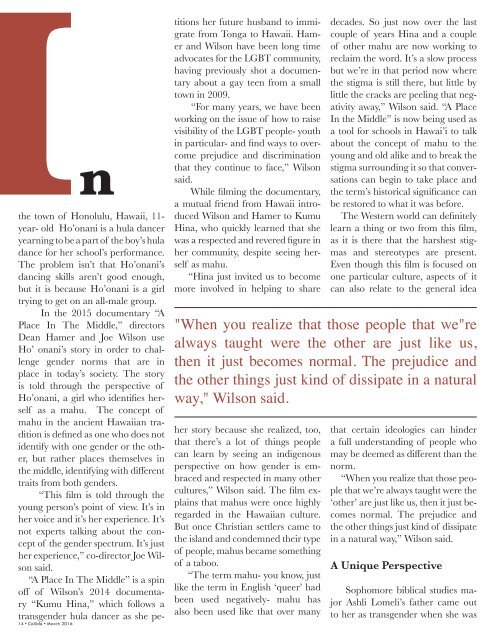Collide Issue 30: The Middle
Create successful ePaper yourself
Turn your PDF publications into a flip-book with our unique Google optimized e-Paper software.
14 • <strong>Collide</strong> • March 2016<br />
n<br />
the town of Honolulu, Hawaii, 11-<br />
year- old Ho’onani is a hula dancer<br />
yearning to be a part of the boy’s hula<br />
dance for her school’s performance.<br />
<strong>The</strong> problem isn’t that Ho’onani’s<br />
dancing skills aren’t good enough,<br />
but it is because Ho’onani is a girl<br />
trying to get on an all-male group.<br />
In the 2015 documentary “A<br />
Place In <strong>The</strong> <strong>Middle</strong>,” directors<br />
Dean Hamer and Joe Wilson use<br />
Ho’ onani’s story in order to challenge<br />
gender norms that are in<br />
place in today’s society. <strong>The</strong> story<br />
is told through the perspective of<br />
Ho’onani, a girl who identifies herself<br />
as a mahu. <strong>The</strong> concept of<br />
mahu in the ancient Hawaiian tradition<br />
is defined as one who does not<br />
identify with one gender or the other,<br />
but rather places themselves in<br />
the middle, identifying with different<br />
traits from both genders.<br />
“This film is told through the<br />
young person’s point of view. It’s in<br />
her voice and it’s her experience. It’s<br />
not experts talking about the concept<br />
of the gender spectrum. It’s just<br />
her experience,” co-director Joe Wilson<br />
said.<br />
“A Place In <strong>The</strong> <strong>Middle</strong>” is a spin<br />
off of Wilson’s 2014 documentary<br />
“Kumu Hina,” which follows a<br />
transgender hula dancer as she petitions<br />
her future husband to immigrate<br />
from Tonga to Hawaii. Hamer<br />
and Wilson have been long time<br />
advocates for the LGBT community,<br />
having previously shot a documentary<br />
about a gay teen from a small<br />
town in 2009.<br />
“For many years, we have been<br />
working on the issue of how to raise<br />
visibility of the LGBT people- youth<br />
in particular- and find ways to overcome<br />
prejudice and discrimination<br />
that they continue to face,” Wilson<br />
said.<br />
While filming the documentary,<br />
a mutual friend from Hawaii introduced<br />
Wilson and Hamer to Kumu<br />
Hina, who quickly learned that she<br />
was a respected and revered figure in<br />
her community, despite seeing herself<br />
as mahu.<br />
“Hina just invited us to become<br />
more involved in helping to share<br />
her story because she realized, too,<br />
that there’s a lot of things people<br />
can learn by seeing an indigenous<br />
perspective on how gender is embraced<br />
and respected in many other<br />
cultures,” Wilson said. <strong>The</strong> film explains<br />
that mahus were once highly<br />
regarded in the Hawaiian culture.<br />
But once Christian settlers came to<br />
the island and condemned their type<br />
of people, mahus became something<br />
of a taboo.<br />
“<strong>The</strong> term mahu- you know, just<br />
like the term in English ‘queer’ had<br />
been used negatively- mahu has<br />
also been used like that over many<br />
decades. So just now over the last<br />
couple of years Hina and a couple<br />
of other mahu are now working to<br />
reclaim the word. It’s a slow process<br />
but we’re in that period now where<br />
the stigma is still there, but little by<br />
little the cracks are peeling that negativity<br />
away,” Wilson said. “A Place<br />
In the <strong>Middle</strong>” is now being used as<br />
a tool for schools in Hawai’i to talk<br />
about the concept of mahu to the<br />
young and old alike and to break the<br />
stigma surrounding it so that conversations<br />
can begin to take place and<br />
the term’s historical significance can<br />
be restored to what it was before.<br />
<strong>The</strong> Western world can definitely<br />
learn a thing or two from this film,<br />
as it is there that the harshest stigmas<br />
and stereotypes are present.<br />
Even though this film is focused on<br />
one particular culture, aspects of it<br />
can also relate to the general idea<br />
"When you realize that those people that we"re<br />
always taught were the other are just like us,<br />
then it just becomes normal. <strong>The</strong> prejudice and<br />
the other things just kind of dissipate in a natural<br />
way," Wilson said.<br />
that certain ideologies can hinder<br />
a full understanding of people who<br />
may be deemed as different than the<br />
norm.<br />
“When you realize that those people<br />
that we’re always taught were the<br />
‘other’ are just like us, then it just becomes<br />
normal. <strong>The</strong> prejudice and<br />
the other things just kind of dissipate<br />
in a natural way,” Wilson said.<br />
A Unique Perspective<br />
Sophomore biblical studies major<br />
Ashli Lomeli’s father came out<br />
to her as transgender when she was


